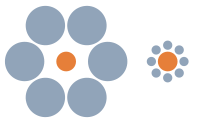
Ebbinghaus illusion
Encyclopedia

Optical illusion
An optical illusion is characterized by visually perceived images that differ from objective reality. The information gathered by the eye is processed in the brain to give a perception that does not tally with a physical measurement of the stimulus source...
of relative size perception. In the best-known version of the illusion, two circles of identical size are placed near to each other and one is surrounded by large circles while the other is surrounded by small circles; the first central circle then appears smaller than the second central circle.
It was named for its discoverer, the German psychologist Hermann Ebbinghaus
Hermann Ebbinghaus
Hermann Ebbinghaus was a German psychologist who pioneered the experimental study of memory, and is known for his discovery of the forgetting curve and the spacing effect. He was also the first person to describe the learning curve...
(1850-1909) it was popularised in the English-speaking world by Titchener in a 1901 textbook of experimental psychology, hence its alternative name "Titchener circles".
Although commonly thought of as an illusion of size, recent work suggests that the critical factor in the illusion is the distance of the surrounding circles and the completeness of the annulus, making the illusion a variation of the Delboeuf illusion
Delboeuf illusion
The Delboeuf illusion is an optical illusion of relative size perception. In the best-known version of the illusion, two circles of identical size have been placed near to each other and one is surrounded by an annulus; the surrounded circle then appears larger than the non-surrounded circle if...
. If the surrounding circles are near to the central circle it appears larger, while if they are far away it appears smaller. Obviously, the size of the surrounding circles dictates how near they can be to the central circle, resulting in many studies confounding
Confounding
In statistics, a confounding variable is an extraneous variable in a statistical model that correlates with both the dependent variable and the independent variable...
the two variables.
The Ebbinghaus illusion has played a crucial role in the recent debate over the existence of separate pathways in the brain for perception and action (for more details see Two Streams hypothesis
Two Streams hypothesis
The two-streams hypothesis is a widely accepted, but still controversial, account of visual processing. As visual information exits the occipital lobe, it follows two main channels, or "streams". The ventral stream travels to the temporal lobe and is involved with object identification...
). It has been argued that the Ebbinghaus illusion distorts perception of size, but when a subject is required to respond with an action, such as grasping, no size distortion occurs. However, recent work suggests that the original experiments were flawed. The original stimuli limited the possibility for error in the grasping action, therefore making the grasp response more accurate, and presented the large and small versions of the stimulus in isolation—which results in no illusion because there is no second central circle to act as a reference. Franz et al. conclude that both the action and perception systems are equally fooled by the Ebbinghaus illusion. Other recent research suggests that an individual's receptivity to this illusion, as well as the Ponzo illusion
Ponzo illusion
The Ponzo illusion is a geometrical-optical illusion that was first demonstrated by the Italian psychologist Mario Ponzo in 1913. He suggested that the human mind judges an object's size based on its background. He showed this by drawing two identical lines across a pair of converging lines,...
, may be inversely correlated with the size of that individual's primary visual cortex.

